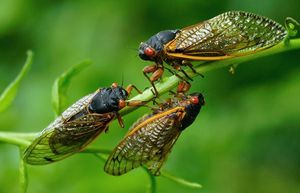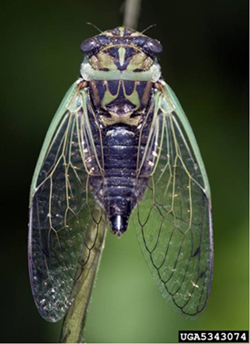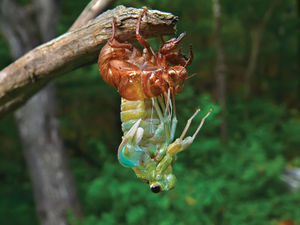Cicadas: Difference between revisions
mNo edit summary |
|||
| (2 intermediate revisions by 2 users not shown) | |||
| Line 1: | Line 1: | ||
[[File: cicada.jpg|thumb|Periodical Cicada - ''Retrieved from'' https://www.scientificamerican.com/article/brood-x-cicadas-could-cause-a-bird-baby-boom/]] | [[File: cicada.jpg|thumb|Periodical Cicada - ''Retrieved from'' https://www.scientificamerican.com/article/brood-x-cicadas-could-cause-a-bird-baby-boom/]] | ||
== Description == | == Description == | ||
Cicadas are members of the family Cicadidae in the order Homoptera [2]. They have two pairs of membranous wings | Cicadas are members of the family Cicadidae in the order Homoptera [2]. They have two pairs of membranous wings and two compound eyes, as well as three simple eyes. Cicadas can range in size from 2 to 5 cm in length [2]. Their coloration can vary from bright orange and red patterns to iridescent greens and blues. Cicadas are easily identifiable by their recognizable vocalizations in the mid and late summer months. Male cicadas are responsible for these vocalizations which are produced by vibrating membranes which are located at the base of their abdomens [2]. The natural song frequency of a cicada is determined by the dimensions of the abdominal cavity and the tympana, which functions as an eardrum membrane in the abdomen [1]. North American species produce a series of rhythmical buzzes or whines, while species from other parts of the world produce more musical vocalizations [2]. Vocalizations can be made for several reasons; for mating, as a sign of disturbance, or as a result of daily weather fluctuations and the songs produced by other nearby males [2] | ||
| Line 18: | Line 18: | ||
Cicadas play a beneficial role in the environment as they aerate the soil as nymphs, prune trees and shrubs as adults, and serve as a source of nitrogen for plants once they die [5]. They also function as an important link in the food chain as almost all insectivorous species will readily eat them when the adults emerge in the summer. Because cicadas emerge in the millions, they are fairly resilient to predation, making them an abundant and reliable food source [5]. However, cicadas can be considered a vulnerable group of [[insects]] as the nymphs are heavily affected by the application of pesticides as well as other lawn and garden chemicals [5]. | Cicadas play a beneficial role in the environment as they aerate the soil as nymphs, prune trees and shrubs as adults, and serve as a source of nitrogen for plants once they die [5]. They also function as an important link in the food chain as almost all insectivorous species will readily eat them when the adults emerge in the summer. Because cicadas emerge in the millions, they are fairly resilient to predation, making them an abundant and reliable food source [5]. However, cicadas can be considered a vulnerable group of [[insects]] as the nymphs are heavily affected by the application of pesticides as well as other lawn and garden chemicals [5]. | ||
Due to the short lifespan and high number of eggs laid by females in one lifecycle, cicadas are deemed predatory by | Due to the short lifespan and high number of eggs laid by females in one lifecycle, cicadas are deemed predatory by farmers due to the large nutrient intake required to sustain the population. This can lead to a decrease in crop vegetation during their adult lifespan, however this only occurs once every 13 or 17 years, depending on the species periodical juvenile gestation period. | ||
== References == | == References == | ||
Latest revision as of 16:48, 27 April 2022

Description
Cicadas are members of the family Cicadidae in the order Homoptera [2]. They have two pairs of membranous wings and two compound eyes, as well as three simple eyes. Cicadas can range in size from 2 to 5 cm in length [2]. Their coloration can vary from bright orange and red patterns to iridescent greens and blues. Cicadas are easily identifiable by their recognizable vocalizations in the mid and late summer months. Male cicadas are responsible for these vocalizations which are produced by vibrating membranes which are located at the base of their abdomens [2]. The natural song frequency of a cicada is determined by the dimensions of the abdominal cavity and the tympana, which functions as an eardrum membrane in the abdomen [1]. North American species produce a series of rhythmical buzzes or whines, while species from other parts of the world produce more musical vocalizations [2]. Vocalizations can be made for several reasons; for mating, as a sign of disturbance, or as a result of daily weather fluctuations and the songs produced by other nearby males [2]
Annual vs. Periodical Cicadas

Cicada species can be divided into two sub-categories based on the timing of their life cycles. Annual cicadas have a life cycle of two to five years and broods overlap, resulting in new adults every year [3]. An example of an annual cicada is the species Neotibicen canicularis, more commonly known as the Dog-Day Cicada [3]. Periodical Cicadas do not appear every year and have life cycles of 13 to 17 years [3]. There are a total of seven species of cicada that are considered periodical, and all belong to the genus Magicicada[3]. Of these seven species, four have a 17-year cycle and are generally found in the north, while the remaining three species have a 13-year cycle and are generally found in more southern regions [3]. Adult periodical cicadas typically emerge in May and June and are identifiable by their black bodies, striking red eyeballs and orange veined wings [3].
Habitat and Range
Over 3,000 species of cicadas are known to exist, ranging in habitat from deserts, to grasslands and forests with most being situated in tropical environments [2]. Within these environments, cicadas inhabit regions with deciduous, woody trees and plants that can support their reproductive and nutritional needs [6]. Nymphs require environments with soil fertile enough to support complex root systems which they can feed upon as they grow [6]. Adults require woody plants with tender, thin twigs in which they can lay their eggs and also extract fluid from food [5]. Annual cicadas can be found worldwide, while periodicals are restricted solely to the central and eastern regions of the United States [4].
Life Cycle
The life cycle of a cicada begins with the laying of eggs in woody plant tissues that will later drop from the plant during or after egg hatching [2]. Female cicadas can lay up to 400 eggs spread over dozens of sites [4]. After 6 to 10 weeks, nymphs emerge from these eggs and burrow into the ground where they will sustain themselves on juices from roots of perennial plants [2]. The nymph phase of the cicada is spent entirely in underground burrows until they emerge to the surface and molt their shells to become adults [4].

This event occurs in synchrony for all emerging adults as it is dependent on the year and soil temperature [4]. Once an adult, the sole purpose of the cicada is to mate and lay eggs. Because of this, the typical lifespan of the newly emerged adult cicadas is usually only about four to six weeks before they die. [4].
Ecological Role
Cicadas play a beneficial role in the environment as they aerate the soil as nymphs, prune trees and shrubs as adults, and serve as a source of nitrogen for plants once they die [5]. They also function as an important link in the food chain as almost all insectivorous species will readily eat them when the adults emerge in the summer. Because cicadas emerge in the millions, they are fairly resilient to predation, making them an abundant and reliable food source [5]. However, cicadas can be considered a vulnerable group of insects as the nymphs are heavily affected by the application of pesticides as well as other lawn and garden chemicals [5].
Due to the short lifespan and high number of eggs laid by females in one lifecycle, cicadas are deemed predatory by farmers due to the large nutrient intake required to sustain the population. This can lead to a decrease in crop vegetation during their adult lifespan, however this only occurs once every 13 or 17 years, depending on the species periodical juvenile gestation period.
References
[1] Bennet-Clark, H. C., and D. Young. (1992). A MODEL OF THE MECHANISM OF SOUND PRODUCTION IN CICADAS:32.
[2] cicada | Description, Life Cycle, & Facts. (n.d.). . https://www.britannica.com/animal/cicada.
[3] Cicada - NYS Dept. of Environmental Conservation. (n.d.). . https://www.dec.ny.gov/animals/91895.html.
[4] Cicadas, facts and photos. 2011, May 10. . https://www.nationalgeographic.com/animals/invertebrates/facts/cicadas.
[5] Periodical Cicadas. (n.d.). . https://www.nwf.org/Home/Educational-Resources/Wildlife-Guide/Invertebrates/Periodical-Cicadas.
[6] Where Do Cicadas Live? Facts About Cicada Habitats. 2018, April 11. . https://www.orkin.com/other/cicadas/habitat.